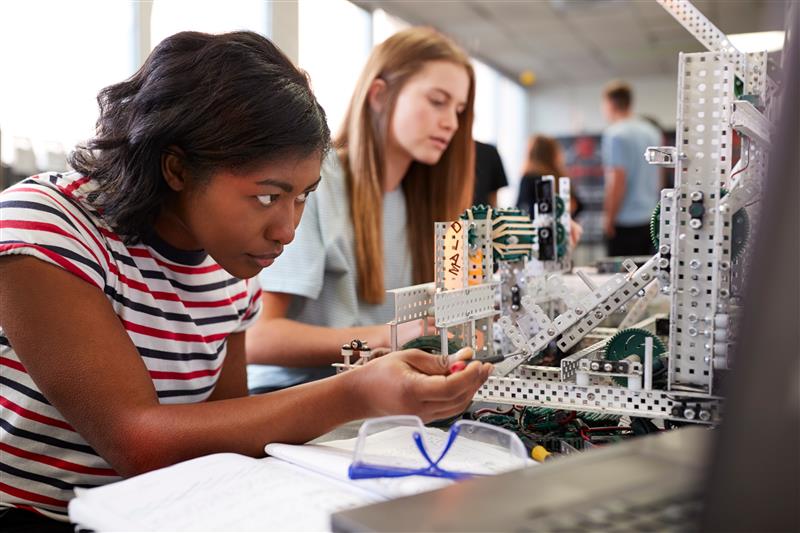BizCover’s Women in IT Scholarship Backs Future Innovators
The number of women enrolling in STEM courses (Science, Technology, Engineering and Mathematics) in Australia is steadily increasing. However, the numbers are still relatively low – only 37% of university STEM enrolments are women, and women only represent 15% of the STEM workforce.
Similarly, the gender pay gap in STEM is closing. But, on the downside, it still stands at around 16%.
Clearly, there is still a lot of work to be done when it comes to promoting gender equity in tech – whether that’s within schools, universities or workplaces.
So, what can be done to help balance the scales in STEM?
Why diversity, equity and inclusion matter in tech
Diversity, equity and inclusion (DEI) initiatives in the workplace are important because they drive innovation, foster positive work environments and boost profits. Based on years of research from all over the world, this is an unassailable fact.
Similarly, DEI is important at an educational level for girls and young women who are thinking of studying a STEM subject. For many girls and young women, they do not see STEM is not a viable or accessible career path and they face challenges and barriers that male students often do not.
However, by studying STEM subjects and contributing to the workforce, they can help to bring different perspectives and ideas to the table that could help fuel exciting, innovative new projects.
Without more participation from women, STEM industries in Australia will fall behind.
How DEI drives innovation
When diverse teams work together, they are able to approach problems from a wider range of perspectives. This can lead to more creative solutions and better outcomes.
In tech, where innovation is essential, diversity of thought is a major competitive advantage.
McKinsey’s 2023 study, Diversity Matters Even More, found that companies with gender-diverse teams had 18% higher profitability than their less diverse counterparts.
Including women, as well as people from various cultural, social and educational backgrounds, helps challenge groupthink, uncover unmet needs and develop technology that genuinely reflects the real world.
In this way, DEI can help to drive innovation as well as help companies financially outperform their competitors.

Supporting the next generation of women in IT
BizCover offers a Women in IT Scholarship which encourages female students to pursue a career in IT.
“Technology is shaping the future of every industry, and it’s critical that women are equally represented in building that future,” says Sharon Kenny, Head of Marketing at BizCover. “Through our Women in IT Scholarship, we’re investing in the next generation of female tech talent—supporting young women to overcome barriers and thrive in a field where their ideas, leadership, and innovation are urgently needed.”
Julia is the latest winner of the BizCover Women in IT Scholarship. She is in her third year of studying Computer Science and Arts at UNSW.
“I was searching online for scholarship opportunities and IT scholarships,” Julia says, “and the BizCover scholarship came up, and it sounded like a great opportunity. So I thought, no harm in applying, right?”
A generational interest in computers and problem-solving
Julia believes that her love of IT slowly evolved over time. Being exposed to computers, programming and coding at a young age helped her realise that she wanted to pursue IT as a career.
“At home, we had a computer that had Scratch on it, which is a block-based programming language,” Julia remembers. “The rule was, if you were doing something productive on the computer then you got priority. So if I was writing a computer game, I would get to use it rather than my siblings if they were playing computer games.”
Julia’s father and grandmother both worked in IT roles, which makes Julia a third-generation computer expert.
“I love problem solving. I used to play with a Rubik’s cube a lot when I was younger,” says Julia. “I’ve always been interested in problem solving, which is what I really love about computer science.”
Speaking about who inspired her to follow a career in STEM, Julia says that her grandma had a big impact on her.
“[In the ‘60s] society thought my grandma should, as a woman, either be a secretary, a nurse or a teacher. And instead, she decided to study a maths degree. Then she started working programming computers using punchcards. Her willingness to try something different that not many other people would have chosen at the time has inspired me.”
Fresh ideas, new solutions
As part of her application, Julia submitted a report on a project that she had worked on.
“Last summer I did an internship with an energy company,” says Julia. “They use drones to take pictures of their power poles in bushfire-prone areas so that any damage can be repaired early.”
The idea is that someone then needs to look through all these images and not only identify the poles in the pictures (usually amongst trees and buildings and other objects), but then determine whether there is damage and if it needs to be fixed. This can be a very time-consuming process, so Julia worked on a solution to speed things up.
“I was involved in part of the image processing pipeline. I used an AI object detection algorithm to place a boundary box around the shafts of the poles in the photos,” she explains.
Using AI to identify the poles helped to streamline the process, saving time and effort.
But can the AI make errors? Yes, Julia says. But part of the fun of working on a project like this is puzzling out how to solve problems and find solutions.
To help the AI make less errors when identifying the poles, Julia says that she worked hard to train the program to get the best results. “I got the first model to label about 1000 images, and then went through and corrected them manually. Then I used this dataset to train the next model. Since it now had more corrected images as training data, it made less mistakes.”

Barriers for women in tech
STEM is still a male-dominated area, and there are many barriers and challenges to overcome for women who want to study or follow a career in IT.
Some of these barriers are less visible than others.
“One [barrier] that comes to mind for me is that a lot of the elective computer science courses are run quite late at night,” says Julia. “I think in general, there’s a late-night culture within computing. Whereas I think a lot of women wouldn’t want to travel alone late at night, especially if they live quite far from campus.”
This may seem like a relatively minor barrier, but faced with the option of travelling home late at night alone, some women could be deterred from taking certain elective courses.
Much like companies that don’t provide work gear fitted for women’s bodies, offering elective classes late at night demonstrates that common concerns for women are simply not considered. Again, this is where DEI is important, as different perspectives can quickly point out overlooked flaws that would not otherwise be considered by the majority. This helps to create an overall more accessible and inclusive environment for everyone.
Cheering on the new generation
While there is much work to be done, the future of women in IT in Australia is looking brighter all the time.
When she thinks ahead to the future and what her career in IT could look like, Julia says that she wants to be able to help young girls find a passion for STEM – just like she did when she was growing up.
“If you haven’t been exposed to [IT], you don’t know whether you like it or not… So I think it’s important to give young girls the opportunity to try it and see that this is an option for them.”
Julia continues, “I don’t think we should force every woman to pursue STEM if they don’t want to. But what’s important is that they have a choice.”
As a leading Insurtech company, BizCover is proud to offer the Women in IT scholarship every year to a deserving young student. We believe that supporting women in tech is an important step towards building a more inclusive and equitable future for everyone interested in a tech-focused career.
This information is general only and does not take into account your objectives, financial situation or needs. It should not be relied upon as advice. As with any insurance, cover will be subject to the terms, conditions and exclusions contained in the policy wording or Product Disclosure Statement (available on our website). Please consider whether the advice is suitable for you before proceeding with any purchase. Target Market Determination document is also available (as applicable). © 2025 BizCover Pty Limited, all rights reserved. ABN 68 127 707 975; AFSL 501769.


![[Press Release] Power loss biggest threat to Australian businesses as storm and fire season approach](https://www.bizcover.com.au/wp-content/uploads/Power-loss-biggest-threat-to-Australian-businesses-as-storm-and-fire-season-approach-1.png)
